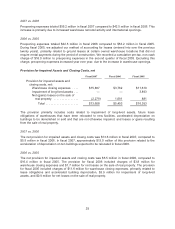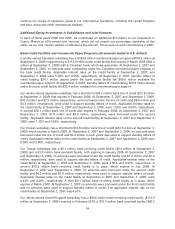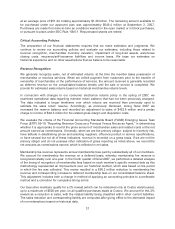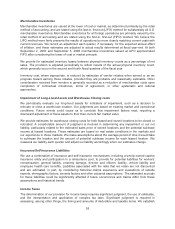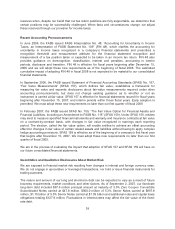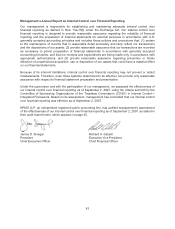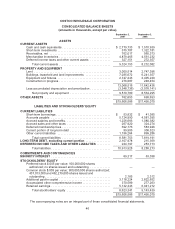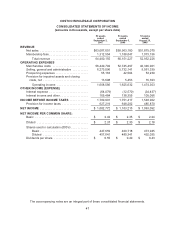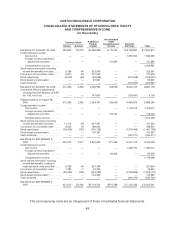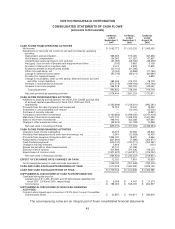Costco 2007 Annual Report Download - page 41
Download and view the complete annual report
Please find page 41 of the 2007 Costco annual report below. You can navigate through the pages in the report by either clicking on the pages listed below, or by using the keyword search tool below to find specific information within the annual report.reserves when, despite our belief that our tax return positions are fully supportable, we determine that
certain positions may be successfully challenged. When facts and circumstances change, we adjust
these reserves through our provision for income taxes.
Recent Accounting Pronouncements
In June 2006, the FASB issued FASB Interpretation No. 48, “Accounting for Uncertainty in Income
Taxes, an Interpretation of FASB Statement No. 109” (FIN 48), which clarifies the accounting for
uncertainty in income taxes recognized in a company’s financial statements and prescribes a
recognition threshold and measurement attribute for the financial statement recognition and
measurement of a tax position taken or expected to be taken in an income tax return. FIN 48 also
provides guidance on derecognition, classification, interest and penalties, accounting in interim
periods, disclosure and transition. FIN 48 is effective for fiscal years beginning after December 15,
2006 and we will adopt these new requirements as of the beginning of fiscal 2008. The estimated
cumulative impact of adopting FIN 48 in fiscal 2008 is not expected to be material to our consolidated
financial statements.
In September 2006, the FASB issued Statement of Financial Accounting Standards (SFAS) No. 157,
“Fair Value Measurements” (SFAS 157), which defines fair value, establishes a framework for
measuring fair value and expands disclosures about fair-value measurements required under other
accounting pronouncements, but does not change existing guidance as to whether or not an
instrument is carried at fair value. SFAS 157 is effective for financial statements issued for fiscal years
beginning after November 15, 2007, and interim periods within those fiscal years. Early adoption is
permitted. We must adopt these new requirements no later than our first quarter of fiscal 2009.
In February 2007, the FASB issued SFAS No. 159, “The Fair Value Option for Financial Assets and
Financial Liabilities, Including an Amendment to FASB No. 115” (SFAS 159). Under SFAS 159, entities
may elect to measure specified financial instruments and warranty and insurance contracts at fair value
on a contract-by-contract basis, with changes in fair value recognized in earnings each reporting
period. The election, called the fair value option, will enable entities to achieve an offset accounting
effect for changes in fair value of certain related assets and liabilities without having to apply complex
hedge accounting provisions. SFAS 159 is effective as of the beginning of a company’s first fiscal year
that begins after November 15, 2007. We must adopt these new requirements no later than our first
quarter of fiscal 2009.
We are in the process of evaluating the impact that adoption of SFAS 157 and SFAS 159 will have on
our future consolidated financial statements.
Quantitative and Qualitative Disclosures About Market Risk
We are exposed to financial market risk resulting from changes in interest and foreign currency rates.
We do not engage in speculative or leveraged transactions, nor hold or issue financial instruments for
trading purposes.
The nature and amount of our long and short-term debt can be expected to vary as a result of future
business requirements, market conditions and other factors. As of September 2, 2007, our fixed-rate
long-term debt included $67.6 million principal amount at maturity of 3.5% Zero Coupon Convertible
Subordinated Notes carried at $47.8 million, $900.0 million of 5.3% Senior Notes carried at $897.8
million, $1.10 billion of 5.5% Senior Notes carried at $1.09 billion and additional notes and capital lease
obligations totaling $127.9 million. Fluctuations in interest rates may affect the fair value of the fixed-
rate debt.
39


